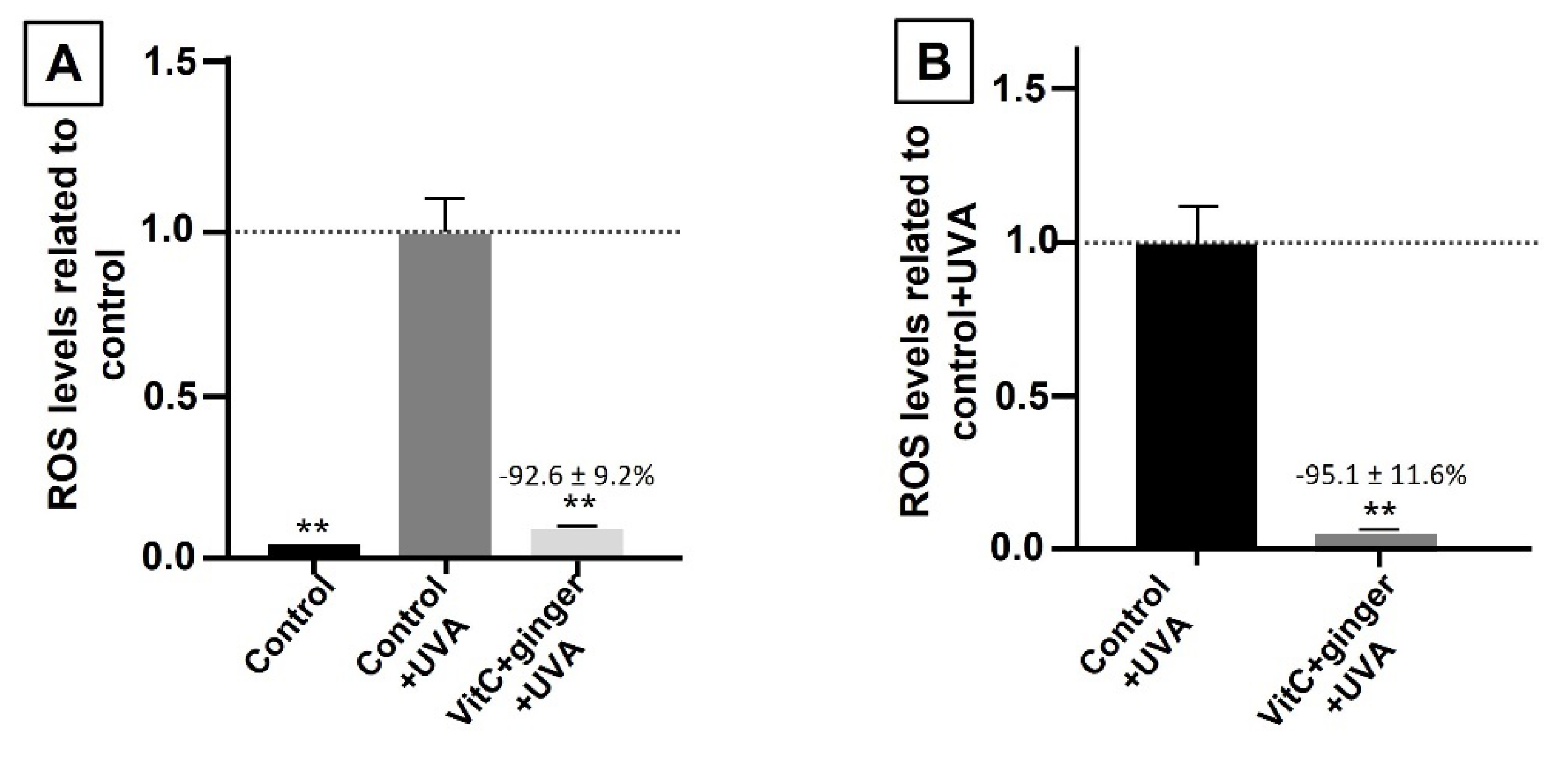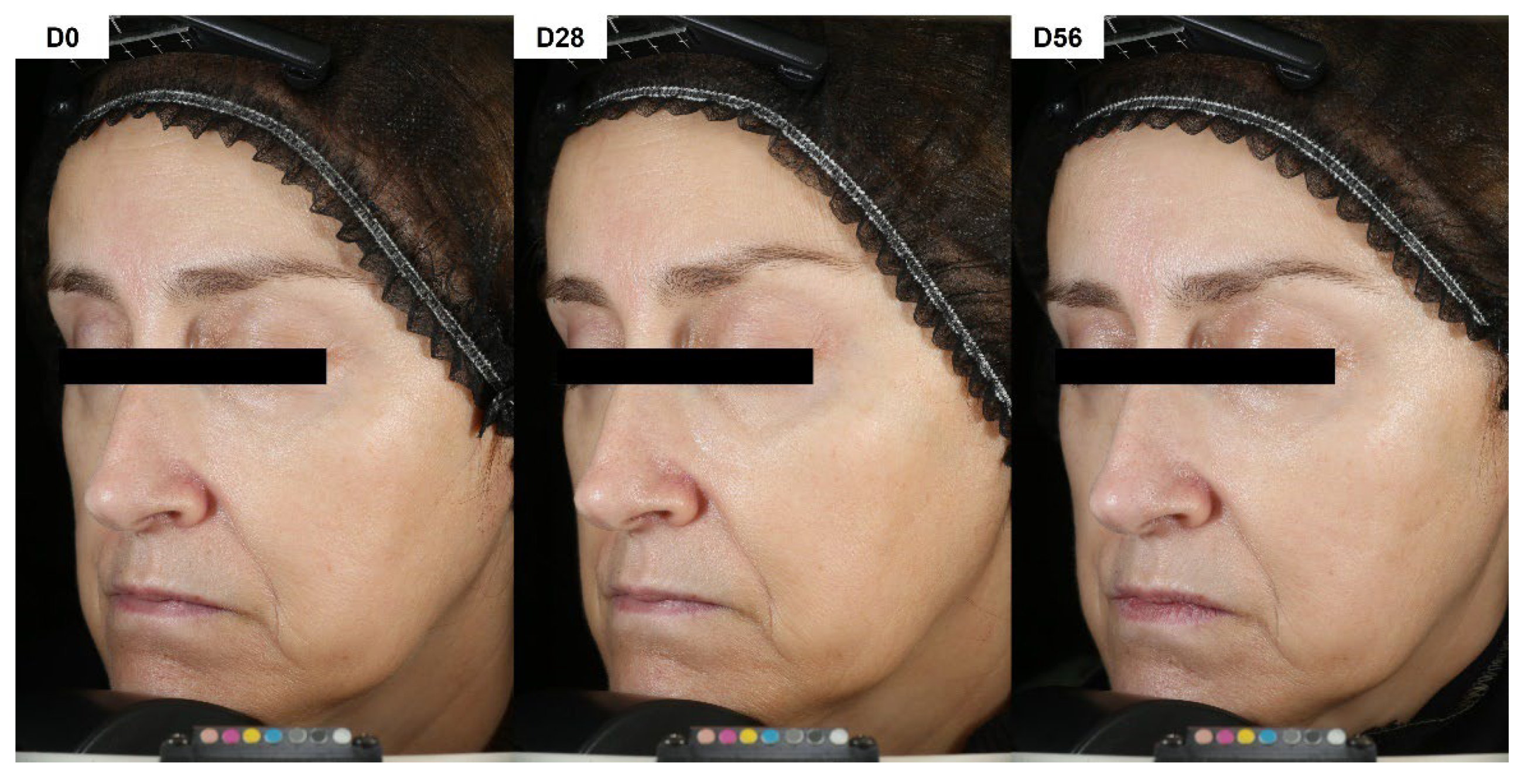Open-Label Study to Evaluate the Efficacy of a Topical Anhydrous Formulation with 15% Pure Ascorbic Acid and Ginger as a Potent Antioxidant
Abstract
:1. Introduction
2. Materials and Methods
2.1. L-Ascorbic Acid Formulations and Content Determination
2.2. In Tubo Study: Why Ginger as an Antioxidant Potentiator?
2.3. Formula Development and Composition
2.4. In Vitro Test: Antioxidative Effect
2.5. Clinical Study: Efficacy, Skin Tolerance, and Cosmetic Acceptance
3. Results
3.1. AA Formulations and Content Determination
3.2. In Tubo Study
3.3. Preclinical Studies—In Vitro
3.4. Clinical Studies
4. Discussion
5. Study Limitations
6. Conclusions
Author Contributions
Funding
Institutional Review Board Statement
Informed Consent Statement
Data Availability Statement
Acknowledgments
Conflicts of Interest
References
- Draelos, Z.D. Dermatología Cosmética, Productos y Técnicas; Grupo Aula Médica: Toledo, Spain, 2011. [Google Scholar]
- Traikovich, S.S. Use of topical ascorbic acid and its effects on photodamaged skin topography. Arch. Otolaryngol. Head Neck Surg. 1999, 125, 1091–1098. [Google Scholar] [CrossRef] [PubMed] [Green Version]
- Nishikimi, M.; Fukuyama, R.; Minoshima, S.; Shimizu, N.; Yagi, K. Cloning and chromosomal mapping of the human nonfunctional gene for L-gulono-gamma-lactone oxidase, the enzyme for L-ascorbic acid biosynthesis missing in man. J. Biol. Chem. 1994, 269, 13685–13688. [Google Scholar] [CrossRef]
- Colven, R.M.; Pinnell, S.R. Topical vitamin C in anging. Clin. Dermatol. 1996, 14, 227–234. [Google Scholar] [CrossRef]
- Tsao, C.S.; Young, M.A. stabilized ascorbic acid solution. Med. Sci. Res. 1996, 24, 473–475. [Google Scholar]
- Al-Niaimi, F.; Chiang, N.Y.Z. Topical Vitamin C and the Skin: Mechanisms of Action and Clinical Applications. J. Clin. Aesthet. Dermatol. 2017, 10, 14–17. [Google Scholar]
- Stamford, N.P. Stability, transdermal penetration, and cutaneous effects of ascorbic acid and its derivatives. J. Cosmet. Dermatol. 2012, 11, 310–317. [Google Scholar] [CrossRef]
- Pinnell, S.R.; Yang, H.; Omar, M.; Monteiro-Riviere, N.; DeBuys, H.V.; Walker, L.C.; Wang, Y.; Levine, M. Topical L-ascorbic acid: Percutaneous absorption studies. Dermatol. Surg. 2001, 27, 137–142. [Google Scholar] [CrossRef]
- Heber, G.K.; Markovic, B.; Hayes, A. An immunohistological study of anhydrous topical ascorbic acid compositions on ex vivo human skin. J. Cosmet. Dermatol. 2006, 5, 150–156. [Google Scholar] [CrossRef]
- Ribeiro Neto, A.C.; Pires, R.F.; Malagoni, R.A.; Moilton, R.F. Solubility of Vitamin C in Water, Ethanol, Propan-1-ol, Water + Ethanol, and Water + Propan-1-ol at (298.15 and 308.15). J. Chem. Eng. Data 2010, 55, 1718–1721. [Google Scholar] [CrossRef]
- Farris, P.K. Topical vitamin C: A useful agent for treating photoaging and other dermatologic conditions. Dermatol. Surg. 2005, 31, 814–817. [Google Scholar] [CrossRef]
- De Dormael, R.; Bastien, P.; Sextius, P.; Gueniche, A.; Ye, D.; Tran, C.; Chevalier, V.; Gomes, C.; Souverain, L.; Tricaud, C. Vitamin C Prevents Ultraviolet-induced Pigmentation in Healthy Volunteers: Bayesian Meta-analysis Results from 31 Randomized Controlled versus Vehicle Clinical Studies. J. Clin. Aesthet. Dermatol. 2019, 12, E53–E59. [Google Scholar] [PubMed]
- Chen, J.; Liu, Y.; Zhao, Z.; Qiu, J. Oxidative stress in the skin: Impact and related protection. Int. J. Cosmet. Sci. 2021, 43, 495–509. [Google Scholar] [CrossRef] [PubMed]
- Yaar, M.; Eller, M.S.; Gilchrest, B.A. Fifty years of skin aging. J. Investig. Dermatol. Symp. Proc. 2002, 7, 51–58. [Google Scholar] [CrossRef] [Green Version]
- Gilchrest, B.A. Skin aging and photoaging. Dermatol. Nurs. 1990, 2, 79–82. [Google Scholar] [PubMed]
- Pandel, R.; Poljšak, B.; Godic, A.; Dahmane, R. Skin photoaging and the role of antioxidants in its prevention. Int. Sch. Res. Not. 2013, 12, 930164. [Google Scholar] [CrossRef]
- Burke, K.E. Interaction of vitamins C and E as better cosmeceuticals. Dermatol. Ther. 2007, 20, 314–321. [Google Scholar] [CrossRef]
- Pullar, J.M.; Carr, A.C.; Vissers, M.C.M. The Roles of Vitamin C in Skin Health. Nutrients 2017, 9, 866. [Google Scholar] [CrossRef] [Green Version]
- Gaspar, L.R.; Campos, P.M. Photostability and efficacy studies of topical formulations containing UV-filters combination and vitamins A, C and E. Int. J. Pharm. 2007, 343, 181–189. [Google Scholar] [CrossRef]
- Kedare, S.B.; Singh, R.P. Genesis and development of DPPH method of antioxidant assay. J. Food Sci. Technol. 2011, 4, 412. [Google Scholar] [CrossRef] [Green Version]
- Bae, E.J.; Seo, S.H.; Kye, Y.C.; Ahn, H.H. A quantitative assessment of the human skin surface using polarized light digital photography and its dermatologic significance. Ski. Res. Technol. 2010, 16, 270–274. [Google Scholar] [CrossRef]
- Callaghan, T.M.; Wilhelm, K. A review of ageing and an examination of clinical methods in the assessment of ageing skin. Part 2: Clinical perspectives and clinical methods in the evaluation of ageing skin. Int. J. Cosmet. Sci. 2008, 30, 323–332. [Google Scholar] [CrossRef] [PubMed]
- Nkengne, A.; Roure, R.; Rossi, A.B.; Bertin, C. The skin aging index: A new approach for documenting anti-aging products or procedures. Skin Res. Technol. 2013, 19, 291–298. [Google Scholar] [CrossRef] [PubMed]
- Chaudhuri, R.K.; Meyer, T.; Premi, S.; Brash, D. Acetyl zingerone: An efficacious multifunctional ingredient for continued protection against ongoing DNA damage in melanocytes after sun exposure ends. Int. J. Cosmet. Sci. 2020, 42, 36–45. [Google Scholar] [CrossRef] [PubMed] [Green Version]
- Dhaliwal, S.; Rybak, I.; Pourang, A.; Burney, W.; Haas, K.; Sandhu, S.; Crawford, R.K.; Sivamani, R. Randomized double-blind vehicle controlled study of the effects of topical acetyl zingerone on photoaging. J. Cosmet. Dermatol. 2021, 20, 166–173. [Google Scholar] [CrossRef]
- Ravetti, S.; Clemente, C.; Brignone, S.; Hergert, L.; Allemandi, D.; Palma, S. Ascorbic Acid in Skin Health. Cosmetics 2019, 6, 58. [Google Scholar] [CrossRef] [Green Version]
- Gallarate, M.; Carlotti, M.E.; Trotta, M.; Bovo, S. On the stability of ascorbic acid in emulsified systems for topical and cosmetic use. Int. J. Pharm. 1999, 188, 233–241. [Google Scholar] [CrossRef]
- Spiclin, P.; Gasperlin, M.; Kmetec, V. Stability of ascorbyl palmitate in topical microemulsions. Int. J. Pharm. 2001, 222, 271–279. [Google Scholar] [CrossRef]
- Raschke, T.; Koop, U.; Düsing, H.J.; Filbry, A.; Sauermann, K.; Jaspers, S.; Wenck, H.; Wittern, K.P. Topical activity of ascorbic acid: From in vitro optimization to in vivo efficacy. Skin. Pharmacol. Physiol. 2004, 17, 200–206. [Google Scholar] [CrossRef]
- Sanadi, R.M.; Deshmukh, R.S. The effect of Vitamin C on melanin pigmentation—A systematic review. J. Oral Maxillofac. Pathol. 2020, 24, 374–382. [Google Scholar] [CrossRef]
- Shindo, Y.; Witt, E.; Han, D.; Epstein, W.; Packer, L. Enzymic and non-enzymic antioxidants in epidermis and dermis of human skin. J. Investig. Dermatol. 1994, 102, 122–124. [Google Scholar] [CrossRef] [Green Version]
- Poljsak, B.; Dahmane, R. Free radicals and extrinsic skin aging. Dermatol Res. Pract. 2002, 2012, 135206. [Google Scholar]
- Hwang, S.W.; Oh, D.J.; Lee, D.; Kim, J.W.; Park, S.W. Clinical efficacy of 25% L-ascorbic acid (C’ensil) in the treatment of melisma. J. Cutan. Med. Surg. 2009, 13, 74–81. [Google Scholar] [CrossRef] [PubMed]
- Telang, P.S. Vitamin C in dermatology. Indian Dermatol. Online J. 2013, 4, 143–146. [Google Scholar] [CrossRef]
- Kim, J.; Lee, Y.I.; Almurayshid, A.; Jung, J.Y.; Lee, J.H. Effect of a topical antioxidant serum containing vitamin C, vitamin E, and ferulic acid after Q-switched 1064-nm Nd: YAG laser for treatment of environment-induced skin pigmentation. J. Cosmet. Dermatol. 2020, 19, 2576–2582. [Google Scholar] [CrossRef] [PubMed]


| AA Content (%) | % Variation over the Time | |||
|---|---|---|---|---|
| Time (Months) | Anhydrous Vehicle | Aqueous Vehicle | Anhydrous Vehicle | Aqueous Vehicle |
| 0 | 14.98 ± 0.050 | 15.18 ± 0.096 | ||
| 2 | 14.95 ± 0.058 | 11.00 ± 0.000 | −0.20 | 27.53 |
| 3 | 14.18 ± 0.050 | 9.83 ± 0.050 | −5.34 | 35.24 |
| Study Substance | Concentration for Maximum Absorbance (μg/mL) | Trolox Equivalent Concentration (μM) |
|---|---|---|
| Vitamin C + E (control) | 28.57 | 578 |
| Vitamin C + E + curcumin | 28.57 | 565 |
| Vitamin C + E + rutin | 28.57 | 550 |
| Vitamin C + E + glutathione | 0.029 | 609 |
| Vitamin C + E + ginger | 0.029 | 603 |
| Demographic Data | Skin | Subjects | |||
|---|---|---|---|---|---|
| Number | 33 (100%) | ||||
| Female | 33 (100%) | Skin reactivity: | |||
| Normal | 20 (60.6%) | ||||
| Mean age | 44.8 | Reactive | 13 (39.4%) | ||
| Age min | 35 | Included | 33 (100%) | ||
| Age max | 55 | Skin condition: | Analysed | 30 (90.9%) | |
| Combined | 12 (36.4%) | Dropouts | 3 (9.1%) | ||
| Phototype I | 1 (3.0%) | Normal | 9 (27.4%) | ||
| Phototype II | 5 (15.2%) | Dry | 8 (24.4%) | ||
| Phototype III | 24 (72.7%) | Oily | 4 (12.1%) | ||
| Phototype IV | 3 (15.2%) | ||||
| Parameter | D0 | D28 | D56 |
|---|---|---|---|
| Skin luminosity evolution | 6.2 | 6.7 | 7.1 |
| Skin luminosity variation | 9.5% | 16.5% | |
| Skin luminosity, statistical significance a | 0.019 | <0.0001 | |
| Skin tone irregularities count evolution | 70.5 | 64.2 | 64.1 |
| Skin tone irregularities count variation | −5.6% | −9.0% | |
| Skin tone irregularities count, statistical significance b | 0.04 | 0.007 | |
| Skin tone irregularities area evolution | 12.7 | 11.9 | 11.1 |
| Skin tone irregularities area variation | −1.8% | −10.0% | |
| Skin tone irregularities area, statistical significance a | 0.289 | 0.022 |
| Question about Cosmetic Efficacy | D28 Satisfied Subjects | D56 Satisfied Subjects |
|---|---|---|
| It revitalizes the skin | 100.0 (1.43) | 100.0 (1.43) |
| It leaves the skin more radiant | 93.3 (1.53) | 96.7 (1.43) |
| It leaves the skin more luminous | 96.7 (1.50) | 96.7 (1.47) |
| It provides a more even skin tone | 93.3 (1.50) | 96.7 (1.40) |
| It improves the appearance of frown lines | 96.7 (1.57) | 96.7 (1.50) |
| It reduces fine wrinkles | 93.3 (1.70) | 96.7 (1.60) |
| It improves skin texture | 90.0 (1.47) | 93.3 (1.43) |
| It leaves the skin softer and smoother | 96.7 (1.30) | 90.0 (1.40) |
| It improves overall appearance of the skin | 96.7 (1.50) | 93.3 (1.50) |
Publisher’s Note: MDPI stays neutral with regard to jurisdictional claims in published maps and institutional affiliations. |
© 2022 by the authors. Licensee MDPI, Basel, Switzerland. This article is an open access article distributed under the terms and conditions of the Creative Commons Attribution (CC BY) license (https://creativecommons.org/licenses/by/4.0/).
Share and Cite
Martínez-Valverde, T.; Crespo, N.; Suñer, E. Open-Label Study to Evaluate the Efficacy of a Topical Anhydrous Formulation with 15% Pure Ascorbic Acid and Ginger as a Potent Antioxidant. Cosmetics 2022, 9, 74. https://doi.org/10.3390/cosmetics9040074
Martínez-Valverde T, Crespo N, Suñer E. Open-Label Study to Evaluate the Efficacy of a Topical Anhydrous Formulation with 15% Pure Ascorbic Acid and Ginger as a Potent Antioxidant. Cosmetics. 2022; 9(4):74. https://doi.org/10.3390/cosmetics9040074
Chicago/Turabian StyleMartínez-Valverde, Tamara, Nuria Crespo, and Elisa Suñer. 2022. "Open-Label Study to Evaluate the Efficacy of a Topical Anhydrous Formulation with 15% Pure Ascorbic Acid and Ginger as a Potent Antioxidant" Cosmetics 9, no. 4: 74. https://doi.org/10.3390/cosmetics9040074
APA StyleMartínez-Valverde, T., Crespo, N., & Suñer, E. (2022). Open-Label Study to Evaluate the Efficacy of a Topical Anhydrous Formulation with 15% Pure Ascorbic Acid and Ginger as a Potent Antioxidant. Cosmetics, 9(4), 74. https://doi.org/10.3390/cosmetics9040074






